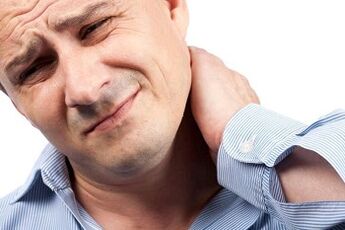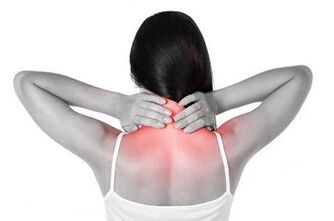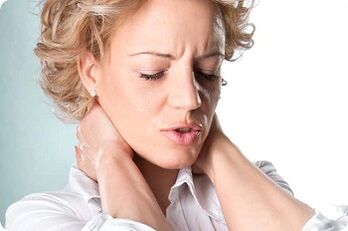
The tendency to plant degenerative-dystrophic spinal cords is growing every year, and all because of hypodynamia and hypokinesia problems are acute due to urbanization.Damage to the cervical spine causes frequent, various headaches and stiffness in the neck and lower arm.Today our topic is the cause, symptoms and treatment of cervical area osteochondrosis.
Reason -As the development of cervical osteochondrosis
Talk about the causes of degenerative damage to the cervical, genetic, toxic, metabolic, endocrine, infectious spine and more -can be listed.However, in the first place you can place an inactive lifestyle and sit on your computer, table and drive.
Frequent stress that voluntarily creates cradle posture, leading to infringement of the nerve blood vessels, helping this pathology.
Symptoms of neck pain cannot be ignored, as this leads to the development of the disease and the development of complications such as the shoulder that supplies periarthrosis, vertebral artery syndrome, anterior staircase syndrome and casting syndrome.
About anatomy structure
Now let's see what the anatomical and physiological features of the cervical spinal structure contribute to the development and development of osteochondrosis:
- The cervical department is the most portable part of the spinal column.Because all types of movement are possible in it, this increases the risk of subluxation and frequent violations;
- The vertebral artery occurs in the channel formed in the hole of the horizontal process of the vertebra.It is the blood that bears the brain, the hearing organs, the spinal cord and the cerebellum.With the development of degenerative-dystrophic changes, arteries and nerves can surround the department.
- In the cervical region, the intervertebral disc is not available anywhere between the vertebrae.At the front, the vertebra is connected to the joints, which can trigger the joint subluxation.
- The hole in the three lower cervical vertebrae have a triangle shape, and with the growth of bone tissue with osteochondrosis, the nerve root can violate.
- During the cervical department, vegetative ganglia is located.
These features will help us present the mechanism of development of cervical spinal osteochondrosis complications.
Mechanism for the development of changes in the cervical spine

The pathological process begins in the intervertebral disc with moisture loss with the pulpoose disc core.The disc fibrous rings gradually become thinner, the elasticity decreases, and the microwave appears.
As a result, the disc loses its ability to set, depreciate and support.The burden on the lower vertebrae gradually increased, after which the vertebra itself was involved in the process.
Small defects appear in it and osteophytes (excess bone growth) develop to withstand increased load.
With bone tissue growth, the nerve root is squeezed along the back wall of the vertebra, and if on the side surface, the vertebral artery is violated.
Subuis in the joints arises due to a violation of the stability between the vertebrae.This leads to tension of the neck muscle compensation, which helps maintain the cervical vertebra in a normal position.
As the muscles become tired, the burden on the vertebra increases, leading to the development of the disease.Therefore, the devil circle is formed where the spasmodic and the damaged spasmodic muscles and the damaged vertebra affect each other and lead to deterioration in the patient's condition.
Based on the pathological mechanism, the symptoms of the disease are formed.Therefore, squeezing the nerve root is characterized by intense paroxysmal pain along the violated nerves.
And when compressing the vertebral artery, symptoms associated with decreased blood flow to the brain, namely: ear sound, dizziness and headache, appear in the first place.
The main symptoms of cervical osteochondrosis.
The main symptoms of cervical osteochondrosis are divided into 3 groups:
The first group of symptoms - pain
It shows itself in the form:
- local pain in the back of the head/neck;
- The illuminated pain, extending to the right or left hand, and can also go to the finger, to a very brush, to the lower arm and even localize it on the shoulder joint.
This pain can be painful and steady, irritating and spreading throughout the neck or hands.Or it is a more acute shooting pain that arises as a result of pinching the nerve roots.
The second group of symptoms is motor disorder
First and foremost, it is the rigidity of the neck and nape, as a result it is impossible to turn on or tilt the head normally, or make movement in the cervical spine.
In addition, this is a limit of mobility in the shoulder joint, called -Periathrosis.It is also possible to spread throughout the hand, including numbness, numbness and numbness along the surface of the shoulder or lower arm.
The third group of symptoms is a manifestation of vegeto-vascular, manifestations of vessels
In this process, either blood vessel cramps or pinching in the spine occur.As a result, symptoms of cervical osteochondrosis can appear as headaches, dizziness, "flies" in front of the eyes.
There is also hearing loss - noise in the ear and the "sulfur plug" feeling, where one does not listen well.These symptoms belong to the vertebral artery syndrome.
Traditional Methods Treatment of cervical osteochondrosis

Modern medicine offers many ways to treat degenerative-dystrophic spinal cord lesions.Among them, they distinguish: drug treatment, manual therapy, folk medicine, therapeutic physical culture (exercise therapy), and in cases of remote use of surgical treatment.The effectiveness of therapy depends on the level of treatment and the complex of selected methods has begun.
Treatment should be intended to normalize the tone of the cervical muscle.Other methods are intended to eliminate inflammation and pain in the field of development of pathological changes.
One important thing in the treatment of osteochondrosis is a good dream, in which experts recommend using orthopedic pillows.
In the early stages of the development of the disease, the use of massage in experienced and self -esteem will be effective.This method will help to loosen the spasmodic muscles and stop the development of the pathological process.
Physical Education Medicine
Treatment of osteochondrosis should include physiotherapy exercises in the form of therapeutic or morning gymnastics.When performing a treatment training complex, comply with the following suggestions:
- wear comfortable clothes and shoes;
- so that there is no shortage of shortness of breath, regular breathing exercises;
- The burden needs to increase gradually, and if during your lesson you begin to mark complaints from the cardiovascular system, then stop training and consult your doctor;
- If the pain appears in the cervical spine during the lesson, then replace it with relaxation and stretching exercises;
- During the lesson, controlling your overall well -being, breathing and pulse;
- If hands -on exercises and loads cause you to express pain, then for a moment, leave them;
- Physical training complex Therapeutic training should be agreed with the doctor.

The following effects are expected from physiotherapy training:
- Strengthen the neck muscles,
- Recovery of blood flow;
- Increased vertebral mobility;
- Increase the amount of movement in the cervix region;
- Eliminating pain and recovery of conservation;
- Prevention of exacerbations.
Drug
Most neuropathologists and other specialists do not represent the treatment of cervical spinal osteochondrosis without drugs.The most popular is the drugs from a group of anti -non -ssteroids (NSAIDs), which are used in the form of injections, tablets, gels and ointments.
Anti -Anti -Anti -Medicine Medicines relieves pain, inflammation and relieves swelling, consequently, restored neck muscle tone, metabolism in the affected area increases, and nerve roots and blood vessels are released from compression.
It is advisable to use medicines from a group of muscle relaxants, which also effectively relieves muscle cramps and at the same time restore their tone.However, medicines should be used carefully, especially in allergies.

Preparation from a group of corticosteroids has received good reviews in the treatment of cervical spinal osteochondrosis.
Injections are very popular due to its anti -neuroprotective effects.
If the treatment described is ineffective, then they use paravertebral blockade with painkillers or steroids.
How to treat cervical osteochondrosis by non -traditional method
Supporters of non -traditional treatment methods can use the following treatment methods.
- AcupunctureIt helps save the patient from pain, relieves swelling and relieves spasmodic muscles, and eliminates nerve and arterial function.If the fingers are numb in the hand, it is advisable to place the needle in an active point in the arm and ear;
- Manual therapyIt helps restore normal blood flow to the neck, relieves muscle cramps and releases pinching nerves.Spinal stretching should be carried out by skilled experts carefully;
- Hirudotherapy (Leech Treatment)It is a cheap and quite effective method of treatment.This procedure consists of placing leeches for biologically active points, which should be repeated with a 10 session course.This method helps restore blood circulation in the cervix region, relieves swelling and inflammation;
- The highest massageIt consists of the effects of the finger on biological active points and helps relieve muscle cramps, improve blood circulation, relieve swelling, pain and inflammation;
- A method of people's treatmentYou can successfully use it at home.These are a variety of self -prepared decoctions and infusions (worm absorption, purple absorption, garlic infusion).Therapeutic baths made from mint, chamomile, wise, calamus rhizomes have a good effect.

After the above method of treatment and refinement with the mechanism of development of the disease, make the decision you contact your problem: to a neuropathologist or a private clinic.

















































